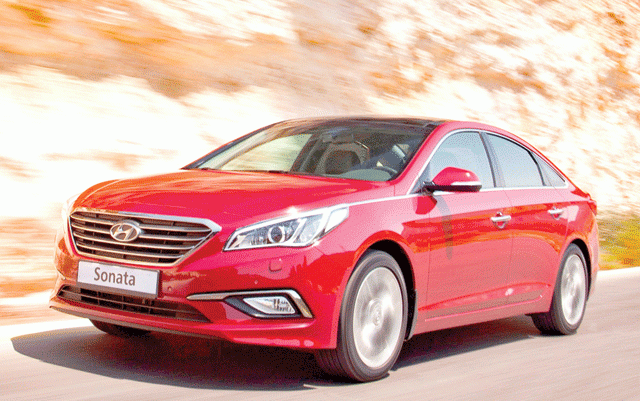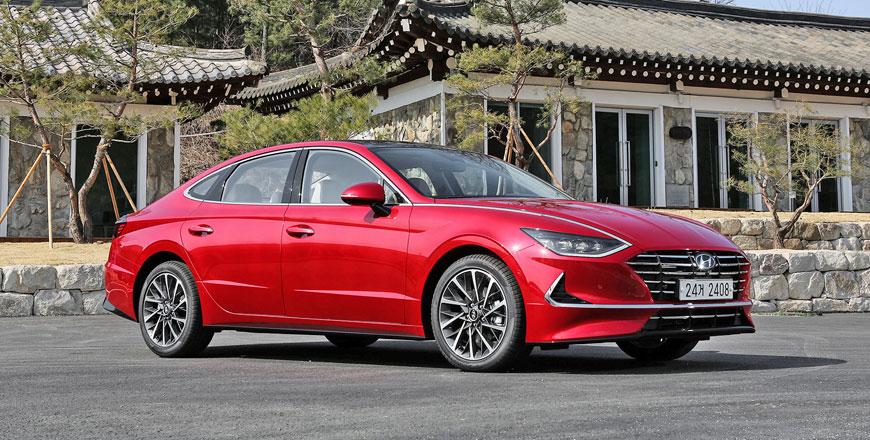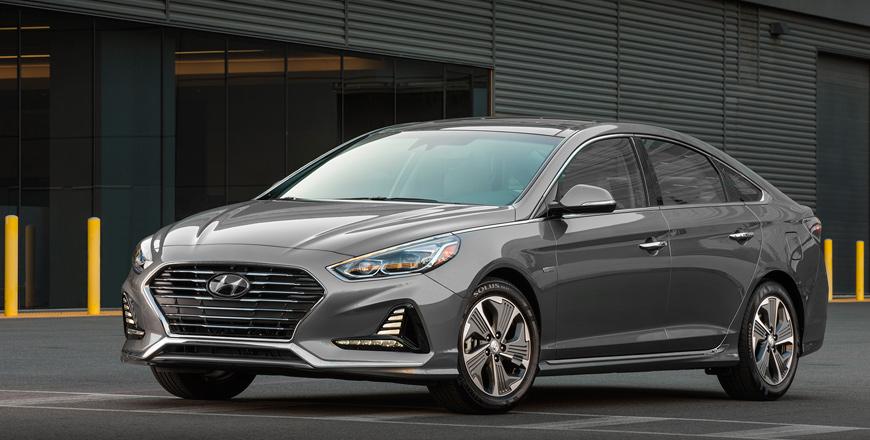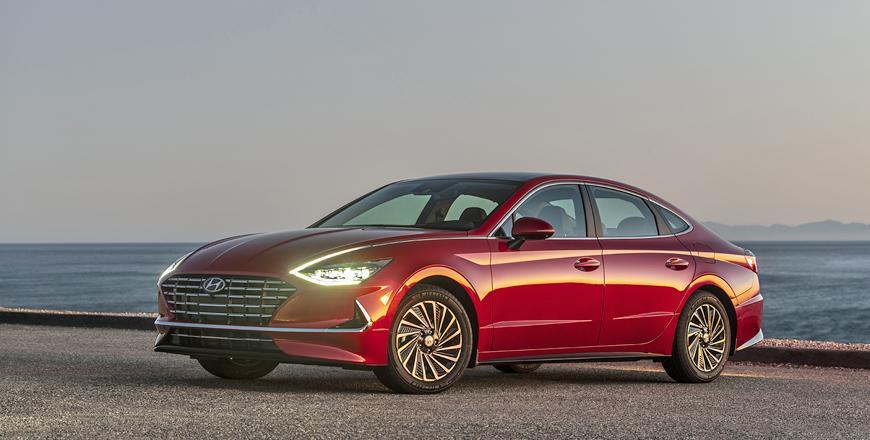You are here
Seventh generation Sonata
By Ghaith Madadha - Sep 29,2014 - Last updated at Sep 29,2014

A follow-up to Hyundai’s radically styled sixth generation Sonata circa 2010, the new 2015 model year seventh generation is an evolutionary but thoroughly redesigned, made-over new model with significant engineering improvements.
A more conservatively elegant redesign featuring Hyundai’s new Fluidic Sculpture 2.0 design language and Modern Premium brand direction first debuted on the Genesis executive saloon of earlier this year, the new Sonata’s design might be less attention grabbing but is more consensually handsome and less polarising.
Launched regionally in Jordan early this month, the new Sonata is being positioned on a slightly more up-market trajectory and features considerable cabin and driving dynamic improvements over the outgoing model.
Different design direction
With a more accessible and universal design, the new Sonata trades its predecessor’s ridged, wavy and concave grille and bonnet for a snouty, elegant and more formal hexagonal three-slat grille and slightly raised bonnet. Stretched sideways rather than upwards, the new Sonata’s headlights neatly trail to the glasshouse’s profile outline. A new and more aggressive bumper design features an upward tilt and larger intakes.
Little altered in general shape the new Sonata retains its predecessor’s rakish roofline and features a similarly strong ridge along its flank, which now runs level above the door handles rather than dramatically rising through the door handles.
More recognisable as evolutionary from the rear, the new Sonata’s rear lights are perhaps less moodily aggressive, but are now more sophisticated looking, with a thin segment extending inwards.
A smooth, flowing and classy looking mid-size family saloon, the new Hyundai Sonata is marginally larger but generates just CD0.27 of aerodynamic drag, which aids highway fuel efficiency and noise refinement. Under the skin, the new Sonata benefits from a greater use of high strength steel and body bracing which yields a 41 per cent increase in torsional rigidity. With a stiffer frame than before, the new Sonata’s frame contributes to improved ride refinement and handling precision.
Spacious seating
Smooth, stable and quiet at highway speeds, the new Sonata benefits from a large underbody cover for better airflow, while cabin refinement from noise vibration and harshness is terrific. The Sonata comfortably accommodates large and tall rear passengers who benefit from generous legroom, which compensates the rakishly low roofline and adequate — rather than generous — rear headroom.
Front seats are comfortable, with rake and tilt steering adjustment providing a good driving position. An optional panoramic roof lends the low roof Sonata an airy feel, while a 462-litre boot is generous. Dashboard layouts are more aesthetically elegant than before, with a hexagonal centre stack reflecting the Sonata’s grille design. Materials and textures are also improved.
Well-kitted, the new Sonata comes with a wide range of standard and optional creature comforts, driver aids and safety systems, including standard A/C, keyless entry, steering wheel controls, Bluetooth and USB connectivity, child seat anchors, electric folding mirrors, ABS brakes, driver’s airbag and LED running and fog lights.
Optional equipment includes passenger and side airbags, electronic stability control, leather seats, heated and ventilated seats, climate control, blindspot detection system, electric rear and manual rear side curtains, rear view camera, parking assist system, and first in its segment, automatic hands-free boot opening. A choice of three infotainment systems is available, with 3.8- or 4.3-inch (9.65 or 10.92 cm) screens.
Smooth driving
With a choice of two- and 2.4-litre four-cylinder engines with multi-point fuel injection (MPI) in Jordan and gasoline direct fuel injection (GDI) in the US market — which also receives a more powerful two-litre turbo version — the driven 2.4 MPI develops 175BHP at 6,000rpm and 168lb/ft at 4,000rpm.
Carried over from its predecessor, the new Sonata’s 2.4 MPI engine is smooth and well insulated from the cabin. Driving the front wheels and mated to a six-speed automatic gearbox with aggressive first and second gear ratios, the 2.4 MPI can carry the Sonata’s estimated 1,510kg mass to a 205km/h maximum and across the 0-100km/h dash in 9.9-seconds.
A smooth and refined engine and gearbox combination for daily town driving and highway commutes, the Sonata 2.4’s progressive delivers adequate mid-range torque and top-end power. Along the Irbid-Amman highway with its many steep inclines, the Sonata 2.4 made confident progress and maintained speeds well.
On such routes one is inclined to use the six-speed automatic’s lever-operated sequential shifts to hold the desired gears. With gearbox shifts designed for silky smooth operation rather than sporty or snappy operation, the Sonata however changes gears quick enough, and one can choose between three gearbox shift modes, including a sport mode more receptive to downshifting and holding gears longer for better responsiveness.
Refined ride
Accounting for 51 per cent of the new Sonata, Hyundai have increased the use of lighter but stiffer high strength steel by 30 per cent and comes in conjunction with improved bracing, subframe mounts and sound insulation for a combination of improvements in ride refinement, driving precision and safety, with the new Sonata being rated a Top Safety Pick+ by the US Insurance Institute for Highway Safety.
With its stiffer frame better allowing the suspension to do its job the new Sonata rides and handles better, while its MacPherson strut front and multi-link rear suspension features revised geometry and redesigned lower suspension arms for improved precision and distribution of lateral forces.
Evolutionary and not revolutionary in driving dynamic, the new Sonata is however certainly an improvement. The strengthened chassis, reworked suspension and recalibrated steering translate into better steering precision and responsiveness through corners.
Body control through corners and the ability to fluidly process rough roads and undulations are also better. An improvement, the new Sonata is built for comfort and refinement and not as a sports saloon. The mid-size segment isn’t generally sports saloon territory, and for those seeking it, the Sonata offers improvement but firmer springs, dampers and rebound control, and sharper steering would be welcome.
However, for its extensive core family clientele, the Sonata’s dynamics, comfort, refinement, equipment and value are spot on.
Technical specifications
Engine: 2.4 litre, 16 valve, DOHC, transverse 4 cylinders
Bore x stroke: 88 x 97mm
Compression ratio: 10.5:1
Gearbox: 6 speed automatic, front-wheel drive
Ratios: 1st 4.212; 2nd 2.637; 3rd 1.8; 4th 1.386; 5th 1.0; 6th 0.772
Final drive/reverse: 3.367:1/3.385
Power, BHP (PS) [kW]: 175 (178) [131] @ 6,000rpm
Specific power: 74BHP/litre
Torque, lb/ft (Nm): 168 (228) @ 4,000rpm
Specific torque: 96.8Nm/litre
0-100 km/h: 9.9-seconds
Top speed: 205km/h
Fuel capacity: 70 litres
Length: 4,855mm
Width: 1,865mm
Height: 1,475mm
Wheelbase: 2,805mm
Tread, F/R: 1,602/1,607mm
Overhang, F/R: 965/1085mm
Ground clearance: 134mm
Aerodynamic drag co-efficient: 0.27
Legroom, F/R: 1,155/905mm
Headroom, F/R: 1,025/965mm
Shoulder room, F/R: 1,470/1,435mm
Boot capacity: 462 litres
Kerb weight: 1,510 (est.)
Suspension: MacPherson struts/Multi-link, stabilizer bars
Steering: Electric assistance, rack & pinion
Lock-to-lock: 2.78 turns
Turning circle: 10.91 metres
Brakes, F/R: Ventilated discs, 304/discs, 284mm
Tyres: 215/55R17
Related Articles
A far more dramatic and stylised car than the somewhat conservative model it replaces, the new eight generation Hyundai Sonata takes a disti
By Ghaith Madadha Among Jordan’s most popular mid-size saloons, the Hyundai Sonata Hybrid is a comfortable, smooth and refined cruiser
An assertively stylised and dramatic design departure from its conservative predecessor, the eight Hyundai Sonata instead harks back to the

Opinion
Apr 09, 2025
Apr 08, 2025
- Popular
- Rated
- Commented
Apr 08, 2025
Apr 09, 2025
Newsletter
Get top stories and blog posts emailed to you each day.

















